Purchasing a new lawn tractor is an exciting time as you imagine all the yard care tasks you’ll accomplish with your shiny new machine. But before visiting dealers and getting swept up in features, consider carefully consider what tractor attributes best match your specific property and needs. The ideal lawn tractor has sufficient power and cutting width to mow your grass efficiently without constantly bumping into trees and fences. Measure your total lawn square footage and shape. Long thin properties need tighter turning tractors.
Haul out a measuring wheel or tape measure to map beds, paths, hills, and other layout features that affect tractor selection.
Determine the right amount of power
Tractor engine horsepower ranges from about 18hp to 30hp for home models. Match power to your yard’s size and terrain so it’s adequate without wasting fuel on overkill. Small, flat yards need basic 18-22hp tractors. Bigger properties, steep hills, and thick grass demand 25hp and up. Expect to use 75% of maximum horsepower for proper operation. Lawn tractor transmissions include manual, hydrostatic, and automatic designs. Manual models require shifting but cost less. Hydrostatic transmissions have variable speed control and suit hills better. Automatics shift themselves while allowing speed changes. Weigh convenience versus price when selecting transmission features.
Check compatible attachments
Think about attachments you’ll need now or in the future like carts, snow plows, sweepers, tillers etc. Then ensure the tractor model operates the implements you want. It may require a higher horsepower engine and specification check. Annoying surprises occur when assumptions have been made. Lawn tractor cutting decks range from 38” on compact tractors up to wide 54” decks for larger lawns. Narrower decks provide tighter turning while wider decks cut more grass per pass. Make sure the deck size you need also fits through gates or tight spaces around your yard and storage.
Analyze fuel options
Tractors commonly run on gas, diesel, or battery power. Gas engines offer affordable operation while diesels provide greater fuel efficiency and torque for heavy work. Electric battery-powered tractors produce zero emissions but have limited run times. Evaluate tradeoffs to select your preferred power source. Basic manual steering takes more upper-body effort to turn sharp corners. Power steering alleviates effort and facilitates sharper turns. Reflect on your mobility requirements, lawn layout, and planning to use the tractor when choosing a steering system. Take both manual and power-steering lawn tractors for sale to make a comparison.
Check ride comfort features
Lawn tractors entail sitting for prolonged periods, so seek models with comfort features like suspension seats, adjustable steering wheels, ergonomic designs, and rubber isolation to reduce vibration. These details make mowing less tiring and more enjoyable. Avoid rock-hard seats that get painful. Set a reasonable budget for what you afford, remembering costlier tractors generally offer greater longevity and features.





